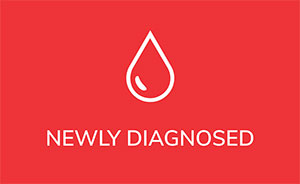Introduction:
Anemia is a common problem in CLL and may be an indication to start treatment. However, it is not always well understood or managed. Too many patients self-treat with iron and other supplements that may not only delay proper care but can cause long-term problems.
Let’s start with a definition.
Definition:
Anemia is when one lacks enough healthy red blood cells or hemoglobin to carry the necessary oxygen to all the body’s tissues. Most demanding are the brain and the heart.
In CLL, guidelines say that treatment is indicated when the hemoglobin drops below 10 grams/deciliter.
Symptoms:
The classic symptoms of anemia are fatigue, shortness of breath (dyspnea), especially with exertion such as climbing stairs, and lightheadedness, especially when getting up quickly. However, it is important to keep in mind that anemia usually develops very slowly in CLL. Patients may dismiss their gradually increasing fatigue and getting winded as a normal part of their chronic lymphocytic leukemia or even their age. Mild anemia is most often asymptomatic and may not need to be treated.
Causes:
Here is the quiz from the CLL Society’s Bloodline that is read at the monthly support group meetings
MONTHLY QUIZ: Anemia (low red blood cell (RBC) count) is a common complication in CLL. All of the following causes are directly related to CLL or its treatment except:
- Crowding in the bone marrow by the CLL cancer cells so there is not enough room left to make red blood cells.
- An enlarged spleen that both hoards and destroys too many red blood cells (RBC).
- Suppression and damage of the bone marrow by chemotherapy or other drugs used to treat CLL.
- Low levels of iron or folate or B12 limit the raw material needed to build new RBC.
- Destruction of the RBC by an auto-immune process (auto-immune hemolytic anemia or AIHA).
- Direct toxic effects on the bone marrow by the CLL.
- A rare complication where a second blood cancer called myelodysplastic syndrome (MDS) develops can lead to bone marrow failure.
The correct answer is #4. Although low iron, folate or B12 may be found in CLL, the disease and its treatment should not directly lead to these deficiencies. All the others are possible causes of anemia in CLL and re-enforces the importance of knowing the correct cause of the anemia, as each type is treated differently. #5, the toxic effects of the disease suppressing the marrow directly were only recently discovered.
Treatment:
A maxim in medicine is that one needs the right diagnosis to choose the right treatment, and it is certainly true for anemia in CLL patients.
The discussion of all the possible therapies is beyond the scope of this brief introduction to anemia but here’s a brief overview:
- For # 1 and 6, the CLL itself needs to be treated to improve the blood count.
- For # 2, also treating the CLL, or in some cases, surgically removing the spleen might help.
- For # 3, it is best, when possible, to avoid chemotherapy and other drugs that can damage or suppress the bone marrow, especially if one is already anemic. Discuss with the doctor if this is a concern with any suggested treatment. Even seemingly innocent drugs such as sulfa antibiotics can suppress the marrow.
- For # 4, this is generally NOT a result of the CLL, and the true cause needs to be discovered. If the iron level is low, internal bleeding usually from the gastrointestinal tract or heavy menstrual flow are the most frequent cause. Unless the iron level is low, taking extra iron can be more than just a waste of money. Iron overload, though rare, can be dangerous and difficult to treat. It is most commonly seen in those who received multiple blood transfusions. Low folate and/or vitamin B12 are rare, but low B12 can be seen in vegans and low folate with a diet bereft of greens.
- For # 5, the first approach is to directly treat the AIHA, usually with immunosuppressive medications.
- For #7, MDS is a rare malignant form of bone marrow failure, most commonly seen years after chemotherapy, and should be treated by a hematologist specializing in MDS.
Summary:
As in CLL, there is no one size fits all for anemia in CLL. Treatment should be individualized based on its cause. Anemia is almost always manageable and with proper therapy, a healthy quality of life can be achieved and maintained.
Stay strong. We are all in this together.
Brian Koffman MDCM (retired) MS Ed
Co-Founder, Executive VP and Chief Medical Officer
CLL Society, Inc.

















